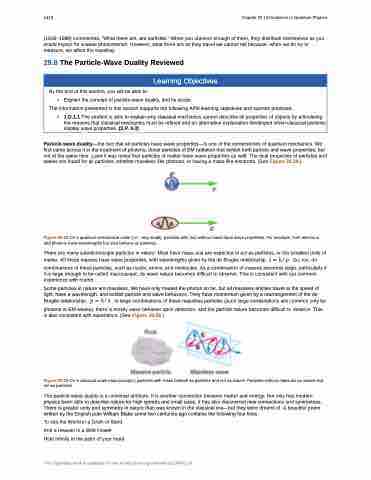Page 1330 - College Physics For AP Courses
P. 1330
1318 Chapter 29 | Introduction to Quantum Physics
(1918–1988) commented, “What there are, are particles.” When you observe enough of them, they distribute themselves as you would expect for a wave phenomenon. However, what there are as they travel we cannot tell because, when we do try to measure, we affect the traveling.
29.8 The Particle-Wave Duality Reviewed
Learning Objectives
By the end of this section, you will be able to:
• Explain the concept of particle-wave duality, and its scope.
The information presented in this section supports the following AP® learning objectives and science practices:
• 1.D.1.1 The student is able to explain why classical mechanics cannot describe all properties of objects by articulating the reasons that classical mechanics must be refined and an alternative explanation developed when classical particles display wave properties. (S.P. 6.3)
Particle-wave duality—the fact that all particles have wave properties—is one of the cornerstones of quantum mechanics. We first came across it in the treatment of photons, those particles of EM radiation that exhibit both particle and wave properties, but not at the same time. Later it was noted that particles of matter have wave properties as well. The dual properties of particles and waves are found for all particles, whether massless like photons, or having a mass like electrons. (See Figure 29.28.)
Figure 29.28 On a quantum-mechanical scale (i.e., very small), particles with and without mass have wave properties. For example, both electrons and photons have wavelengths but also behave as particles.
There are many submicroscopic particles in nature. Most have mass and are expected to act as particles, or the smallest units of matter. All these masses have wave properties, with wavelengths given by the de Broglie relationship � � � � � . So, too, do
combinations of these particles, such as nuclei, atoms, and molecules. As a combination of masses becomes large, particularly if it is large enough to be called macroscopic, its wave nature becomes difficult to observe. This is consistent with our common experience with matter.
Some particles in nature are massless. We have only treated the photon so far, but all massless entities travel at the speed of light, have a wavelength, and exhibit particle and wave behaviors. They have momentum given by a rearrangement of the de Broglie relationship, � � � � � . In large combinations of these massless particles (such large combinations are common only for
photons or EM waves), there is mostly wave behavior upon detection, and the particle nature becomes difficult to observe. This is also consistent with experience. (See Figure 29.29.)
Figure 29.29 On a classical scale (macroscopic), particles with mass behave as particles and not as waves. Particles without mass act as waves and not as particles.
The particle-wave duality is a universal attribute. It is another connection between matter and energy. Not only has modern physics been able to describe nature for high speeds and small sizes, it has also discovered new connections and symmetries. There is greater unity and symmetry in nature than was known in the classical era—but they were dreamt of. A beautiful poem written by the English poet William Blake some two centuries ago contains the following four lines:
To see the World in a Grain of Sand And a Heaven in a Wild Flower
Hold Infinity in the palm of your hand
This OpenStax book is available for free at http://cnx.org/content/col11844/1.14


